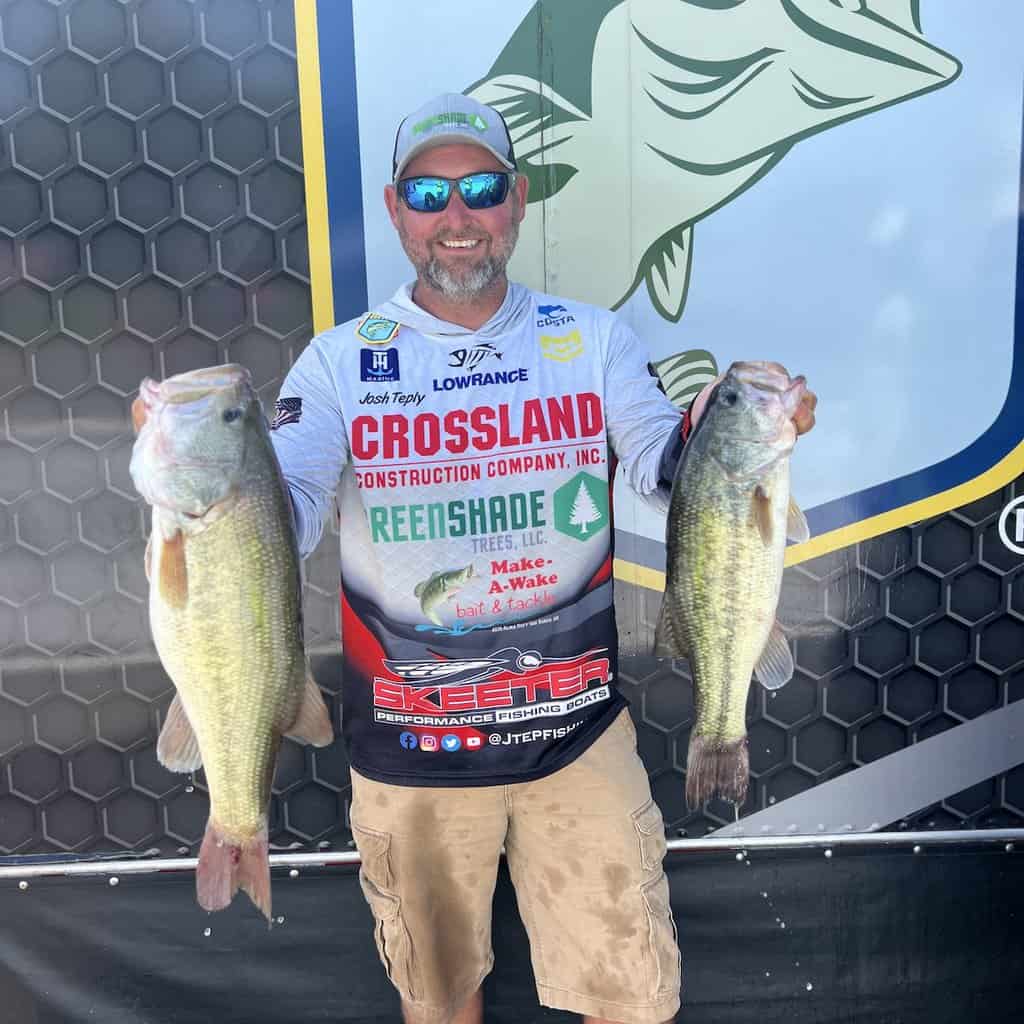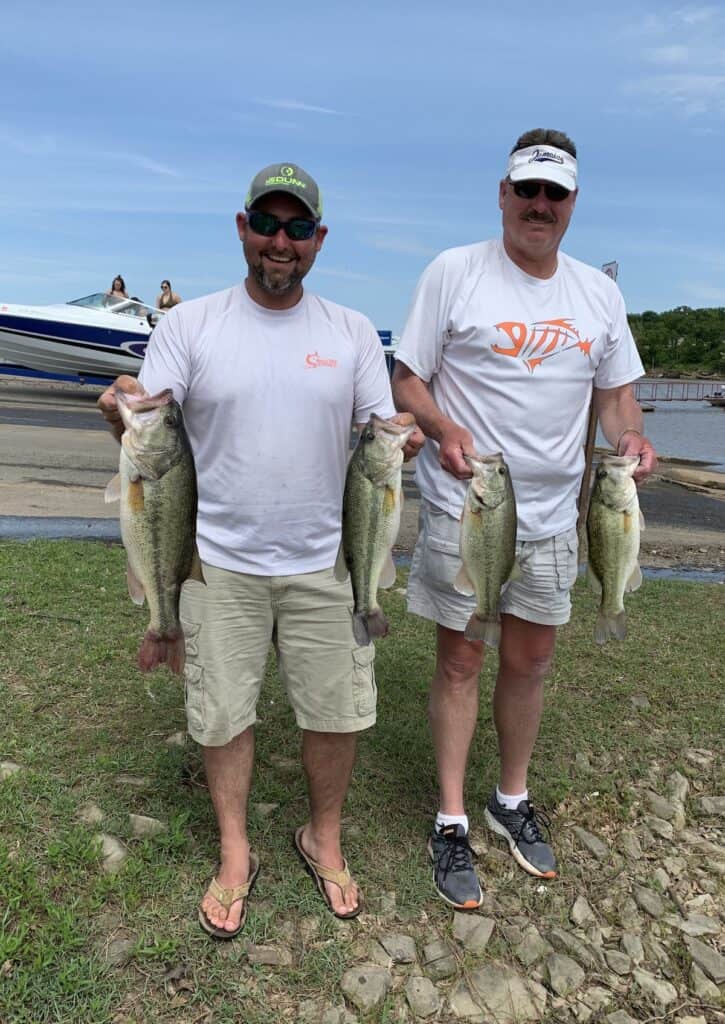Whether you’re looking for big water or big fish, Oklahoma’s largest lake has you covered. Eufaula Lake is 105,500 surface acres when full, which means there’s plenty of water to fish in solitude.
This lake is gigantic; you’d need at least a month, and probably much more, to thoroughly fish the entire reservoir.
If you were to take that month, you would find it’s home to some of the largest fish in the state, no matter the species you’re targeting.
Whether after black bass, catfish, crappie, white bass, or whatever bites, you will have a great time at this impoundment, also known as Eufaula Reservoir or Lake Eufaula. (The latter is not to be confused with a common name for a lake way over on the Alabama-Georgia state line).
Don’t hesitate to bring the family with you to this hotspot a couple hours east of Oklahoma City, as there are plenty of activities around the lake to keep them entertained for hours on end.
Let’s get started with some bass fishing tips.
Lake Eufaula Bass Fishing
Eufaula will show out whether you’re a bank beater or an offshore angler because there are largemouth, smallmouth, and spotted bass.
Black bass follow a consistent seasonal pattern that helps anglers know where they should be fishing, depending on the time of year.
Bass will move to shallow flats near a drop-off in early spring to spawn. These spawning areas will have a hard rocky or sandy bottom.
Once they’re done spawning in late spring, bass begin cruising the shoreline, hanging out in brush piles and vegetation, and heading for their summer locations in deeper water.
During the heat of the summer, you’ll find bass suspended in 10-20 feet of water, often along ledges, points, and definitely boat docks, fishing guide Josh Teply said.
The fall season brings bass back to the shallows to feed up for winter, where once again, they’ll spend most of their time holding around ledges.
Each year, at least a couple of major tournaments and countless small bass fishing contests and jackpots are held here. That can make these fish wary. So check out the following tips to prepare to fish for pressured bass.
Largemouth Bass
For the bank beaters, largemouths are the species to target. You’ll find them in the shallows, under docks, brush piles, and vegetation.
I’m not saying you won’t catch largemouths a little way offshore and in deep water during the winter or middle of summer, but you’re more likely to find smallies and spots in those areas.
Largies are much better suited for murky water than the other two species found in the reservoir.
Both Highway 69 bridges are great places to start your search for largemouths, as well as the I-40 bridge. If that’s not panning out, try fishing main lake points and working your way back into some creeks and coves.
Because Eufaula Lake bass see so much pressure, sometimes slight changes to your lure selection and lures make all the difference.
When I fish here, I love throwing a crankbait along the rip rap banks; jigs and Texas rigs work really well in the vegetation, as do spinnerbaits and bladed jigs.
Lure color will depend on water clarity.
I go with black & blue or bright chartreuse in murky or dirty water. I stick with natural colors like white or green pumpkin for clearer water (Eufaula isn’t known for being crystal clear).
Using a little bit of scent or dye can really help make your lure appear more natural and differentiate it from all the other lures the bass are seeing.
Smallmouth Bass
Eufaula Lake was stocked with reservoir-strain smallmouth throughout the 1990s. This strain of smallmouths is much better suited for the slower-moving waters of an artificial lake. They’re often found in rocky areas a little farther away from shore than largemouths.
I tend to catch more smallies off main lake points and humps in more transparent water, so I stick to the east side of the lake around the dam when targeting smallmouth bass.
The Highway 9 bridges are both great places to begin your search for smallmouth, then move onto the many points jutting out in the lake.
Because smallmouth are a schooling bass, once you get one bite, there are likely a few others nearby, so don’t be afraid to cast back into that spot a few times, especially with different lures.
Speaking of lures, I downsize mine when targeting smallies. This helps them get it in their mouth better and helps me catch a lot more because they can get the hook into their mouth. My color selection remains about the same for smallmouth as for largemouth.
Spotted Bass
The spotted bass are for the offshore anglers. They spend most of their time patrolling the ledges and tend to spawn in deeper water than largemouth and smallmouth.
Spotted bass also prefer clear water, so the east side of the lake, closer to Eufaula Dam, will be where you want to spend most of your time when fishing for spots.
There’s also a giant population of spots on the south side near the Gaines Access, even though the water isn’t as clear, Teply said.
Fishing creek channel ledges, main lake points, and humps are some of the best places to find them. Deep boat docks are another good spot, and you’ll likely find them around the Highway 9 bridges, as well.
Using the same lures you use for smallies will be best, though they can handle some larger lures since they have bigger mouths than smallmouth bass.
Natural colors tend to work best, especially shad colors, such as white and silver, since shad are their primary food source.
Flukes and hair jigs are two of the best lures to catch spotted bass on, as are deep-diving crankbaits.
Catch More Bass
Find the best bass fishing lakes across Oklahoma.
Now, learn some new ways to catch them with our easy bass fishing tips and techniques.
Eufaula Lake Crappie Fishing
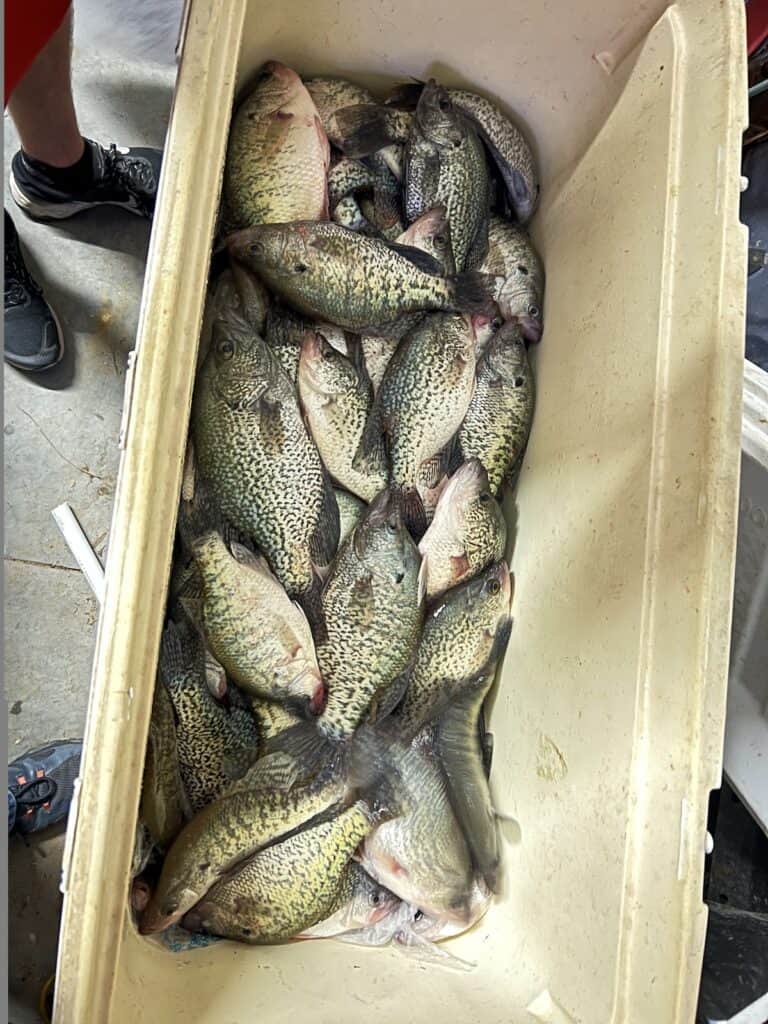
Eufaula Lake is one of Oklahoma’s best crappie fishing lakes. It’s home to black and white crappie, and while each species has its preferences, anglers often will catch them side by side in the same general area using the same lure.
White crappie are better suited for murky or muddy water, which means you’ll find a higher concentration of them on the north and west sides of the lake. Black crappie like the clear water, so you’ll likely catch more of them on the east side of the lake.
During the early spring, crappie begin to stage and move shallow to spawn along rocky and wooded areas. Standing timber, laydowns, and rocky flats near creek channels are great places to start in the spring.
Minnows and natural or brightly-colored crappie jigs work best this time of year.
The summer heat pushes the crappie to deep brush piles in about 15-25 feet of water.
Typical crappie fishing tactics using live minnows, crappie jigs, and small crankbaits are the ticket during the summer. Small spoons are another one of my go-to lures for crappie fishing in deeper water during the summer.
Crappies will move back a little shallower during the fall to brush piles and rocky flats in 10-15 feet to go on a feeding binge before heading back deep for the winter. However, even on warm winter days, you might find a school of crappie patrolling a shallow wooded flat.
It’s no surprise any of the bridges that cross the lake are excellent places to begin your search for these tasty fish. If the marina allows it, you can fish under and around the docks, as these shady spots are some of the best locations during the summer.
Catfishing at Eufaula Lake
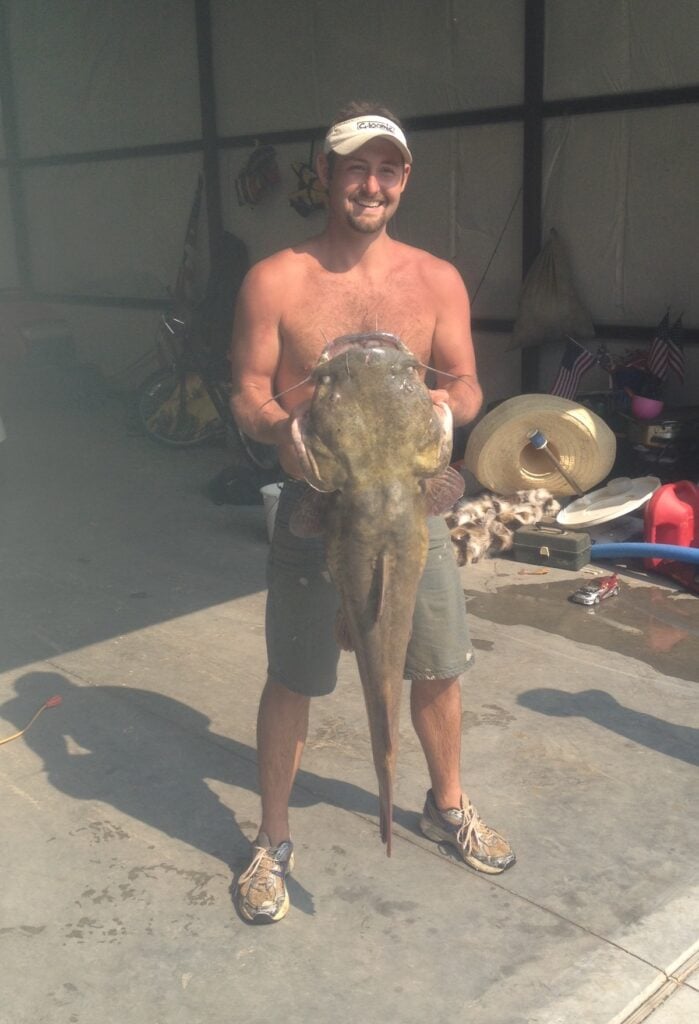
Eufaula Lake won’t disappoint you if you’re a catfisherman or woman, as it’s home to some of the best catfishing in Oklahoma. The three major species of catfish call these waters home: channel cats, blues, and flatheads.
Understanding the spawning cycle will put you far ahead of other anglers.
Catfish spawn on shallow flats and rocky areas in late spring or early summer. They prefer to make a nest in small caverns or overhangs. They’re much harder to catch this time of year because they focus on making and guarding their nests.
As summer sets in and they finish spawning, they head for the deeper holes in the creek and river channels. Catfish use channels as highways to move from location to location.
During the fall, they follow the shad schools back shallow to gorge themselves for winter. Then they’ll move back deep, still following the shad.
While you might catch all three species in the same location, you can vary your bait and technique to target a specific species.
Channel Catfish
Channel catfish are the smallest of the three species but are more than big enough to fill a freezer.
When I want to catch channel cats, I like using nightcrawlers, small chicken liver chunks, hotdogs, or prepared stink bait.
You can run a trotline or jugs or use a rod and reel to catch them. When using a trotline and jugs, be sure you have the correct number of hooks according to the regulations.
As their name implies, these catfish spend a lot of time in creek and river channels. Channel catfish are scavengers, so keeping your baits as close to the bottom as possible is best.
Blue Catfish
Blue catfish inhabit in the same areas, have a similar diet, and anglers use the same methods as they would for channel catfish. The main difference is blues get much larger; the state record is nearly 100 pounds. Which means you’ll want stronger gear and bigger baits.
When targeting blue catfish, I use large chunks of cut bait, such as shad, crappie, white bass, or sunfish.
Be sure to check the regulations on catching bait, as you cannot legally catch crappie and white bass using a cast net; they must be caught using a rod and reel.
The best time overall to catch blue catfish here and other Oklahoma lakes is in February, especially in main lake pockets and the mouths of creeks, Teply said.
Flathead Catfish
Flatheads are the oddballs of the three species, which is probably why they’re also the most sought-after. They get big, though not as big as blues.
They also inhabit similar locations as blues and channels, so you can have a trifecta day where you catch all three species.
Besides the noticeable visual differences, especially their namesake noggins, flathead catfish are more active hunters and have a slightly different diet. They prefer live bait over cut bait most of the time.
The same techniques are used to catch flatheads as blues and channels. You’ll find a lot of flatheads in log jams and big brush piles in the rivers and creeks that flow into Eufaula Lake.
You’ll see many Oklahomans noodling for these fish on flats during the spawn. If you don’t know what noodling is, you stick your hand in a hole (the fish’s nest) and annoy it until it bites you, and then you grab onto it and pull it out of the hole.
Lots of big flatheads (50 pounds+) are caught yearly doing this, but it’s very dangerous. If you’re going to noodle, go with someone else who knows what they are doing.
Catch More Catfish
Best Catfish Fishing Lakes and Rivers in Oklahoma
Catch more with these simple catfishing tips, tricks and best baits.
Eufaula Lake White Bass (and Hybrid Stripers)
If I’ve said it once, I’ve said it a thousand times: White bass, or sand bass as we Okies call them, are the most underrated fish in the lake. They fight hard, and the action can be nonstop once you find them.
Sanies aren’t bad on the dinner table, either, and Eufaula Reservoir is one of the best lakes in Oklahoma for white bass.
Their cousins, hybrid striped bass, are often found in schools with white bass. Hybrids (or “wipers” in some places) are just as fun to catch, if not a little more fun, thanks to the striped bass genes that make them a bit larger.
For both species, the primary food source at Eufaula Lake is shad. So no matter what time of year you’re fishing, any lure that imitates a shad in color and size will likely trigger a bite or two.
Sandies spawn in the early spring. They’ll swim up the creeks and rivers and spawn in brush piles and rocky areas.
I always look for a deep hole near a shallow area, as they’ll congregate in the deep hole and then move up to spawn. Casting a crankbait, small jig, or minnows are the most effective way to catch them during this time.
During the summer, they return to the main river channel and lake. I love trolling with spoons or crankbaits once this happens.
Idling around the channels and flats until you find them is a great way to spend a morning with some friends or family. Be sure to keep a good grip on your rod, though, as when they hit, they can rip it out of your hands.
During the fall, white bass and hybrids follow the shad back shallow and feed along the flats before returning to deeper water during the winter.
Catch More White Bass
I’ve collected a list of favorite sand bass fishing lakes around Oklahoma.
Now, check out my top fishing techniques and other tips to catch more white bass.
Eufaula Lake Striper Fishing
Stripers are a relative of the white bass, and as mentioned, you get hybrids by crossing striped bass with white bass.
The Canadian River immediately below Eufaula Dam is a much better place to catch pure stripers if you don’t have a boat, because they are common in the Arkansas River system.
However, be prepared to lose some tackle as you are likely to get snagged on the rocks.
Overall, the lake itself isn’t a huge draw for stripers, but there are some there and perhaps one guide who chases them, Teply said.
Catch More Stripers
What are Oklahoma’s Best Striper Fishing Lakes? (Includes Hybrid Stripers)
Sunfish Fishing
If you just want to catch a lot of fish, grab a box of nightcrawlers and head to the shore or a dock to catch some sunfish. You’ll likely catch bluegill, green sunfish, and redear sunfish (a.k.a. shellcracker) just about anywhere you go on the lake.
You will find sunfish in vegetation, brush piles, rock piles, and under docks near the shore. They are easy to find and catch, which makes them a remarkable species to introduce a kid to fishing.
I love using an ultra-light rod and reel, but almost anything, including the old cane pole, will work. If you’re at the lake for catfish or stripers, you can always keep several and use them for bait.
Catch More Sunfish
Bluegill and Sunfish Fishing: Simple Techniques and Tips
Planning Your Trip to Eufaula Lake
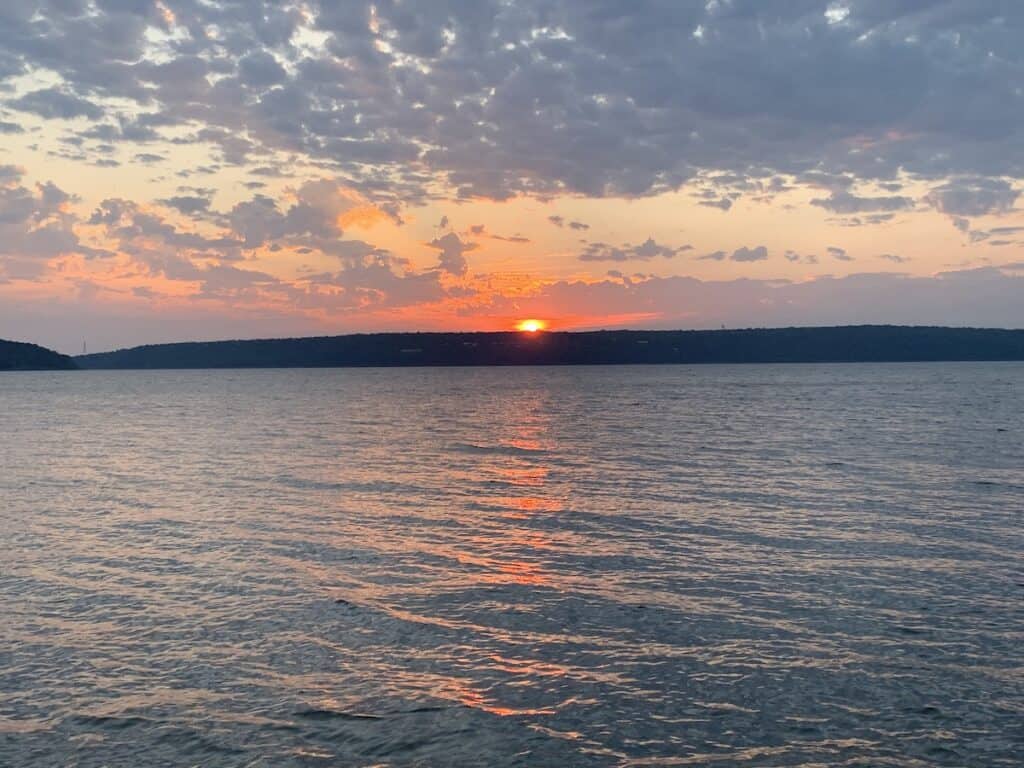
The key to an excellent trip to Eufaula Reservoir is a great plan. This section will help you plan your fishing and other family activities, such as hiking, swimming, ATVing, biking, and disc golfing.
Where is Eufaula Lake?
The North and South Canadian Rivers and multiple creeks feed this massive reservoir.
From Oklahoma City heading east, you can reach parts of this reservoir in a little under to a little over two hours of driving. Figure on about an hour and 20 minutes heading southeast from Tulsa toward the town of Eufaula and nearby parts of the lake.
Besides Eufaula, there are several small communities and multiple residential areas lining the lakeshore, and cities, including McAlester and Henryetta, are close enough for supply runs.
Boat Access
As expected on such a large lake, dozens of boat ramps are scattered around the lake, so no matter where you plan to fish, there’s likely a place to launch close by. These include numerous public parks or recreation areas and private businesses.
Lake Eufaula State Park and Arrowhead State Park have launches as well as marinas. Another handful of marinas are available around the lake as well for those who are looking to keep their boat in the water.
The U.S. Corps of Army Engineers has produced a long list of boat ramps and other services at Eufaula Lake.
Bank Access
Because the Corps of Engineers manages the lake and the Oklahoma State Parks manage some campgrounds, nearly 834 miles of shoreline are open to the public. However, not all of it is easily accessible because of the terrain.
Luckily, many public access areas at the campgrounds and some of the boat ramps give anglers plenty of solid fishing opportunities.
Below the dam is a common place where many bank anglers fish.
Lake Eufaula State Park in Checotah on northwest side is one of the most popular places to visit while at the lake, and there is lots of water access to the northern mid-lake here.
Arrowhead State Park also provides lake access, camping, and other amenities near Canadian on the southwestern side of the reservoir.
Where to Stay
Whether you plan on camping or staying at a hotel, there are lots of places to choose from that surround the reservoir and neighboring towns.
Campgrounds include the state parks listed above, as well as a variety of public and private campgrounds and RV parks near the lake. The Corps list linked under Boat Access above also details some camping options.
If you prefer the comforts of a hotel, there are multiple options not far from the lake in Eufaula, McAlester, and other communities.
Acknowledgment
Thanks to Josh Teply Fishing for providing expert tips for this article.

